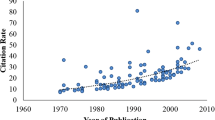Abstract
Purpose
Bibliometric analyses have gained popularity for studying scientific literature, but their application to evaluate technological literature (patents) remains unexplored. We conducted a bibliometric analysis on the top 100 most-cited patents in scoliosis surgery.
Methods
Multiple databases were queried using The Lens to identify the top 100 scoliosis surgery patents, which were selected based on forward patent citations. These patents were then categorized into 8 groups based on technological descriptors and assessed based on various factors including earliest priority date, year issued, and expiration status.
Results
The top 100 most-cited patents included technology underlying anterolateral tethering and distraction systems (n = 11), posterior tethering and distraction systems (n = 23), posterior segmental bone anchor and rod engagement systems (n = 29), interbody devices (n = 10), biological and electrophysiological agents for scoliosis treatment and/or improved arthrodesis (n = 8), intraoperative arthroplasty devices (n = 5), orthotic devices (n = 12), and implantable devices for non-invasive, postoperative alterations of skeletal alignment (n = 2). Seventy-five patents were expired, 21 are still active, and 4 were listed as inactive. The late 1970s and early 2000s saw increased numbers of patent filings. Demonstrated trends showed no meaningful correlation between patent rank and earliest priority date (linear trendline y = 0.2648x – 477.27; R2 = 0.0114), while a very strong correlation was found between patent rank and citations per year (power trendline y = 118.82x−−0.83; R2 = 0.8983).
Conclusion
Patent bibliometric analyses in the field of spinal deformity surgery provide a means to assess past advancements, better understand what it takes to make a difference in the field, and to potentially facilitate the development of innovative technologies in the future. The method described is a reliable and reproducible technique for evaluating technological literature in our field.
Level of evidence
3.






Similar content being viewed by others
References
Cornwall GB, Davis A, Walsh WR, Mobbs RJ, Vaccaro A (2020) Innovation and new technologies in spine surgery, Circa 2020: a fifty-year review. Front Surg. 7:575318. https://doi.org/10.3389/fsurg.2020.575318
Marcus HJ, Hughes-Hallett A, Kwasnicki RM, Darzi A, Yang GZ, Nandi D (2015) Technological innovation in neurosurgery: a quantitative study. J Neurosurg 123(1):174–181. https://doi.org/10.3171/2014.12.JNS141422
PubMed. Bibliometrics. https://pubmed.ncbi.nlm.nih.gov/?term=bibliometrics&sort=date. Accessed April 1, 2023.
PubMed. Neurosurgery Biblometrics. https://pubmed.ncbi.nlm.nih.gov/?term=neurosurgery+bibliometrics&sort=date. Accessed April 1, 2023
Bohl MA, Ponce FA (2017) Assessing the relevancy of highly cited works in neurosurgery. Part I: the 100 most relevant papers in neurosurgical journals. World Neurosurg. 104:927–938. https://doi.org/10.1016/j.wneu.2017.03.149
Bohl MA, Turner JD, Little AS, Nakaji P, Ponce FA (2017) Assessing the relevancy of “citation classics” in neurosurgery. Part II: foundational papers in neurosurgery. World Neurosurg. 104:939–966. https://doi.org/10.1016/j.wneu.2017.03.150
Hani U, Mulvaney GG, O’Brien MD et al (2023) Review: patent bibliometrics in cranial neurosurgery: the first bibliometric analysis of neurosurgery’s technological literature. World Neurosurg 171:115–123. https://doi.org/10.1016/j.wneu.2022.12.103
Eugene G (1979) Citation indexing—its theory and application in science, technology, and humanities. Wiley, New York
Garfield E (1957) Breaking the subject index barrier-a citation index for chemical patents. J Pat Soc 39:583
Ponce FA, Lozano AM (2010) Highly cited works in neurosurgery. Part I: the 100 top-cited papers in neurosurgical journals. J Neurosurg 112(2):223–232. https://doi.org/10.3171/2009.12.JNS091599
Ponce FA, Lozano AM (2010) Highly cited works in neurosurgery. Part II: the citation classics: a review. J Neurosurg 112(2):233–246. https://doi.org/10.3171/2009.12.JNS091600
About The Lens. https://about.lens.org/. Accessed April 1, 2023
Baron RB, Kessler RA, Bhammar A et al (2020) Patents and innovation among neurosurgeons from the American association of neurological surgeons. Cureus. 12(2):e7031. https://doi.org/10.7759/cureus.7031
Carpenter MP, Narin F, Woolf P (1981) Citation rates to technologically important patents. World Pat Inf 3(4):160–163. https://doi.org/10.1016/0172-2190(81)90098-3
Trajtenberg M (1990) A penny for your quotes: patent citations and the value of innovations. RAND J Econ 21(1):172. https://doi.org/10.2307/2555502
Narin F, Hamilton KS, Olivastro D (1997) The increasing linkage between U.S. technology and public science. Res Policy 26(3):317–330. https://doi.org/10.1016/S0048-7333(97)00013-9
Meyer M (2000) Does science push technology? Patents citing scientific literature. Res Policy 29(3):409–434. https://doi.org/10.1016/S0048-7333(99)00040-2
Funding
No funding source to report.
Author information
Authors and Affiliations
Contributions
UH: study conceptualization, data interpretation, drafting the original manuscript, and approval of the final manuscript. JWC: data acquisition and analysis, drafting the original manuscript, and approval of the final manuscript. CH: data interpretation, critically revising the manuscript, study supervision, and approval of the final manuscript. MJMG: data interpretation, critically revising the manuscript, study supervision, and approval of the final manuscript. PKK: data interpretation, critically revising the manuscript, study supervision, and approval of the final manuscript. SC: data interpretation, critically revising the manuscript, study supervision, and approval of the final manuscript. MAB: study conceptualization, data acquisition and analysis, critically revising the manuscript, study supervision, and approval of the final manuscript.
Corresponding author
Ethics declarations
Conflict of interest
The authors report no conflicts of interest in the drugs, materials, or devices described in the article.
Informed consent
No informed consent was needed, because the study was a review of existing literature and did not involve any contact with human subjects.
IRB approval
No IRB approval was needed, because the study was a review of existing literature and did not involve any contact with human or animal subjects.
Additional information
Publisher's Note
Springer Nature remains neutral with regard to jurisdictional claims in published maps and institutional affiliations.
Rights and permissions
Springer Nature or its licensor (e.g. a society or other partner) holds exclusive rights to this article under a publishing agreement with the author(s) or other rightsholder(s); author self-archiving of the accepted manuscript version of this article is solely governed by the terms of such publishing agreement and applicable law.
About this article
Cite this article
Hani, U., Chen, J.W., Holland, C. et al. Patent bibliometrics in spinal deformity: the first bibliometric analysis of spinal deformity’s technological literature. Spine Deform 12, 25–33 (2024). https://doi.org/10.1007/s43390-023-00767-x
Received:
Accepted:
Published:
Issue Date:
DOI: https://doi.org/10.1007/s43390-023-00767-x



